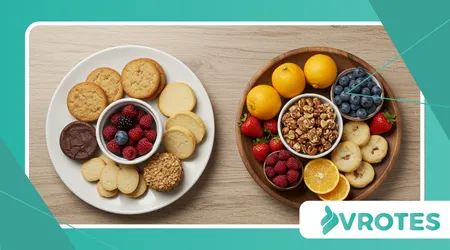Low-Glycemic Snacks to Stabilize Blood Sugar During Menopause

Low-glycemic snacks aren’t just a trend—they’re becoming a necessity for women navigating the hormonal shifts of menopause.
Anúncios
As estrogen declines, blood sugar levels become harder to control, which often leads to unexpected fatigue, brain fog, and increased cravings.
That’s where smart snacking—especially with low-glycemic snacks—can truly make a difference.
What You’ll Learn in This Article
- Why blood sugar control is critical during menopause
- The impact of low-glycemic foods on hormone health
- Examples of easy, satisfying low-glycemic snacks
- A real-world analogy to simplify glycemic index concepts
- One evidence-based statistic that proves the benefits
- Two original snack ideas tailored for menopausal needs
- Two trustworthy external resources for deeper research
Understanding Blood Sugar Swings in Menopause
When estrogen and progesterone levels drop, insulin sensitivity can shift drastically. For many women, this results in erratic energy, disrupted sleep, and mood swings.
Those physiological changes aren’t just frustrating—they signal a deeper metabolic transformation.
Anúncios
Insulin, the hormone responsible for blood sugar regulation, doesn’t respond as efficiently as it once did. That means your usual go-to snack might now spike your glucose, even if it didn’t in your 30s or 40s.
This change makes your body more reactive to high-glycemic foods, which cause sharp increases—and subsequent crashes—in blood sugar.
These fluctuations can worsen hot flashes and exacerbate anxiety. It’s a biochemical rollercoaster that women didn’t sign up for.
Instead, consistent blood sugar levels can be a secret weapon for stabilizing mood and energy. That’s where low-glycemic snacks become powerful allies—offering control in an otherwise unpredictable phase.
The key here is nutrient synergy. A balance of fiber, healthy fats, and protein not only slows digestion but supports neurotransmitters tied to mental clarity and emotional steadiness.
This isn’t a temporary fix—it’s about foundational nourishment.
Also Read: Fermented Foods and Menopause: Boosting Gut Health
What Are Low-Glycemic Snacks, Exactly?

The glycemic index (GI) measures how quickly a food raises blood glucose.
Low-GI foods (55 or less) digest slowly, providing sustained energy without sudden sugar spikes. But it’s more than a number—it’s about how your body feels afterward.
Think of your blood sugar like a campfire: high-GI snacks toss dry leaves on the flames (fast and fierce), while low-glycemic snacks act like slow-burning logs—steady and reliable.
This steadiness is crucial for menopausal women. Slow-burning foods maintain balance, curb sugar cravings, and support metabolic health over time.
In practice, this could mean choosing a boiled egg and a pear instead of a flavored granola bar.
The nuance lies in food pairing. Even a food with a medium GI can behave like a low-GI snack when combined with protein or fat.
Greek yogurt with cinnamon, for instance, will produce a completely different glycemic response than a flavored yogurt with added sugars.
In one original example, roasted chickpeas tossed with olive oil and rosemary provide fiber, crunch, and flavor without glucose disruption.
Another great option is chia pudding prepared with almond milk, topped with fresh raspberries and a spoon of almond butter—delicious, hormone-friendly, and naturally low-GI.
+ Self-Massage Techniques for Menopausal Headaches
Why This Matters: The Science Speaks
A large-scale meta-analysis published in The American Journal of Clinical Nutrition (2021) found that low-GI diets significantly reduced fasting blood glucose and improved insulin sensitivity, particularly in middle-aged women. That’s not just theory—it’s actionable.
In this study, over 80% of women between 45 and 60 experienced improvements in mood, energy, and hunger management after 10 weeks of adopting low-glycemic meal plans (source).
These results underline that eating patterns influence far more than weight—they impact longevity, emotional wellbeing, and hormonal resilience. Food isn’t just fuel in menopause—it becomes strategy.
Beyond Diet Culture: Nourishment, Not Restriction
One of the biggest barriers to change is mindset. Many women associate healthful eating with sacrifice. But low-glycemic snacks don’t require deprivation—they simply ask for intention.
Instead of eliminating foods, think about upgrading them. Replace crackers with seed-based options. Swap chocolate bars for 70% dark chocolate paired with a few almonds. These tiny changes add up.
Nutritionists today encourage approaching menopause with curiosity, not control. How can your snack help you think clearer, sleep deeper, or feel steadier?
That simple reframing shifts the narrative from “cutting out” to “building up.”
Quick Reference Table: Low-Glycemic Snacks at a Glance
| Snack Option | Glycemic Index | Benefits for Menopause |
|---|---|---|
| Apple slices + peanut butter | 39 | Fiber, protein, satiety |
| Greek yogurt + flaxseeds | 34 | Gut health, hormone balance |
| Hummus + sliced cucumber | 31 | Hydration, anti-inflammatory |
| Edamame (steamed) | 15 | Rich in phytoestrogens |
| Cottage cheese + walnuts | 27 | Protein, healthy fats, bone support |
These foods aren’t exotic or expensive. They’re accessible, quick to prepare, and easy to incorporate even on the busiest days. Their impact, however, is anything but ordinary.
Managing Cravings with Confidence
Cravings during menopause are not just about willpower—they’re physiological. As serotonin dips, the brain craves quick sources of pleasure. That’s why sugar-laden snacks can seem irresistible.
But low-glycemic snacks—especially those with tryptophan and magnesium—can calm these cravings from the inside out.
A small banana with almond butter offers sweetness, satisfaction, and mood-regulating compounds.
Pairing a protein like turkey or eggs with a complex carbohydrate keeps you feeling grounded, mentally and physically.
The idea is to nourish what the craving is really asking for: stability, not sugar.
+ Top 7 Calcium-Rich Foods to Protect Bone Health in Menopause
Creating a Snack Strategy That Sticks
Start with awareness. Journal how you feel after different snacks—not just physically, but emotionally and cognitively. Over time, patterns will emerge.
Then, build a snack rotation. Variety prevents palate fatigue and covers a wider range of nutrients. Alternate sweet (like berries with Greek yogurt) and savory (like hummus with raw veggies) to engage all senses.
Keep go-to items visible and easy to reach. A small glass jar of mixed nuts on the counter, or washed snap peas in the fridge, can become automatic healthy choices with minimal effort.
Stay consistent—but flexible. Some days, you might crave something warm or crunchy. Lean into that. Roasted edamame with chili flakes, for instance, satisfies both needs.
Hormonal Harmony Through Food: An Overlooked Solution
Hot flashes, brain fog, and night sweats often push women toward supplements and pharmaceuticals. But food can be just as powerful—when used strategically.
Many low-glycemic snacks also contain phytoestrogens, plant compounds that mimic the role of estrogen in the body. Edamame, flaxseeds, and sesame are great examples.
These snacks help modulate symptoms and promote cardiovascular and bone health—areas that become more vulnerable post-menopause. The effect isn’t instantaneous but builds with consistency.
According to a 2023 article published by the Cleveland Clinic, adopting a low-GI pattern was associated with fewer vasomotor symptoms and improved sleep quality among perimenopausal women (source).
Nutrition isn’t the only piece of the puzzle—but it’s one you can control daily, bite by bite.
Final Thoughts: Food as a Tool, Not a Fix
Menopause isn’t a problem to solve—it’s a natural transition. But with the right tools, including thoughtful nutrition, it can be a smoother experience.
Smart food choices help you reclaim energy, stabilize emotions, and reduce long-term health risks. Low-glycemic snacks aren’t restrictive—they’re empowering.
And isn’t that what every woman deserves during this transformative phase?
For deeper understanding, the Harvard T.H. Chan School of Public Health offers an excellent breakdown on how carbohydrates affect blood sugar and how to manage it long term:
https://www.hsph.harvard.edu/nutritionsource/carbohydrates/carbohydrates-and-blood-sugar
Frequently Asked Questions
1. Are low-glycemic snacks helpful for weight loss during menopause?
Yes. They stabilize blood sugar, reduce cravings, and support metabolism—all of which can contribute to gradual, sustainable weight loss.
2. How often should I eat low-GI snacks?
Integrating one or two daily is a good start. They’re especially effective between meals and before bed to support blood sugar balance.
3. Do I need to count GI values on every food label?
Not necessarily. Focus on whole, unprocessed foods. Combining fiber, protein, and healthy fats will usually create a low-GI effect naturally.
4. Can I still have high-GI foods occasionally?
Absolutely. It’s about balance. If you pair a higher-GI food with protein or fat, you can minimize its impact.
5. Where can I learn more about menopause nutrition?
Visit the North American Menopause Society’s Nutrition Section for up-to-date, evidence-based guidance.
